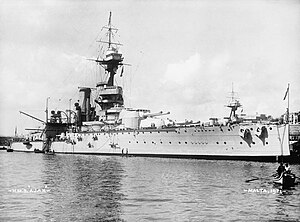HMS Ajax (1912)
|
|
|
|---|---|

|
|
| Ship data | |
| Keel laying : | February 27, 1911 |
| Launch: | March 21, 1912 |
| Commissioning: | October 31, 1913 |
| Builder: | Scott's Ship Yard, Greenock River Clyde |
| Crew: | 759–782 men, 900 war crew |
| Technical specifications | |
| Displacement : | Construction: 23,300 ts maximum: 25,700 ts |
| Length between perpendiculars: length over all: |
L pp = 169.2 m L oa = 182.1 m |
| Width: | 27.1 m |
| Draft : | 8.74 m |
| Machinery: | 4 sets of Parsons steam turbines 18 Yarrow steam boilers in 4 boiler rooms |
| Drive: | 4 three-bladed propellers |
| Power on the waves: | 27,000 WPS |
| Top speed: | 21.7 kn |
| Driving range: | 4,060 nm at 18.1 kn |
| Fuel supply: | 900–3,150 ts coal 800 ts heating oil |
| Armor | |
| Belt armor: | top: 203 mm middle: 304 mm bottom: 229 mm |
| Side armor: | Bow: 102 mm Foredeck: 152 mm Stern: 64 mm |
| 4 armored bulkheads: |
Bulkhead 1 : 51 mm bulkhead 2 : 203 mm bulkhead 3 : 152 mm bulkhead 4 : 102 mm |
| Tank longitudinal bulkhead : | 25-45 mm |
| Upper deck: | 25 mm |
| upper armored deck: | 38 mm |
| lower armored deck: | 64-102 mm |
| Command tower in front: | horizontal: 76 mm vertical: 279 mm |
| Aft command tower: | horizontal: 102 mm vertical: 152 mm |
| Heavy Artillery Towers: | Fronts: 279 mm Sides: 279 mm Ceilings: 102 mm |
| Heavy Artillery Barbettes : | 229-254 mm |
| Casemates : | 25-76 mm |
| Armament | |
| Heavy artillery: | 10 × 13.5 "(343 mm) L / 45 in 5 twin towers |
| Middle artillery : | 16 × 4 "(102 mm) L / 50 in 16 single mounts |
| Underwater torpedo tubes : |
3 × 21 "(533 mm) 2 sides, 1 rear |
| Whereabouts | |
| Transferred to Reserve Fleet in 1924 and written off. Scrapped in December 1926. | |
The HMS Ajax was a British battleship and the fourth of four ships in the first King George V class . The class was a typical representative of the dreadnought battleships of its time.
Was built HMS Ajax from the Scotts Ship Building and Engineering Ltd. in their shipyard in Greenock on the River Clyde. Sister ships were the HMS King George V , HMS Audacious and HMS Centurion .
First World War
The HMS Ajax was assigned to the 2nd Battle Squadron (2nd battleship squadron) of the British Grand Fleet immediately after its commissioning on October 31, 1913 . With this she took part in the Battle of the Skagerrak . There she was one of the first ships to have visual contact with the leading III. Squadron of the Imperial Fleet was able to produce and then opened fire. HMS Ajax was not damaged during the battle, this was their only participation in a naval battle of the First World War . She stayed in Scapa Flow until the end of the war .
post war period
After the end of the First World War she was detached to the Mediterranean Fleet and took part in sea operations against the Bolsheviks and Turkish nationalists in the Black Sea and the Marmara Sea. The last sultan of the former Ottoman Empire was exiled on HMS Ajax .
In April 1924, HMS Ajax returned to Devonport and was then transferred to the Reserve Fleet , at the same time the ship was written off and scrapped. After the sale to Alloa Shipbreaking Co. on December 10, 1926, HMS Ajax was scrapped beginning on December 14, 1926 in Rosyth .
literature
- Siegfried Breyer: Battleships and battle cruisers 1905–1970. JF Lehmanns Verlag, Munich 1970, ISBN 3-88199-474-2
- Robert Gardiner (Ed.): Conway's All the World's Fighting Ships 1922-1946. Conway Maritime Press London 1980, ISBN 0-87021-913-8
- Robert Gardiner (Ed.): Conway's All the World's Fighting Ships 1906-1921. P. 30 Conway Maritime Press, 1985, ISBN 0-85177-245-5
- British Battleships. Oscar Parkes, p. 482 ISBN 0-85052-604-3
- British Battleships of World War One. RA Burt, p. 169, ISBN 0-85368-771-4